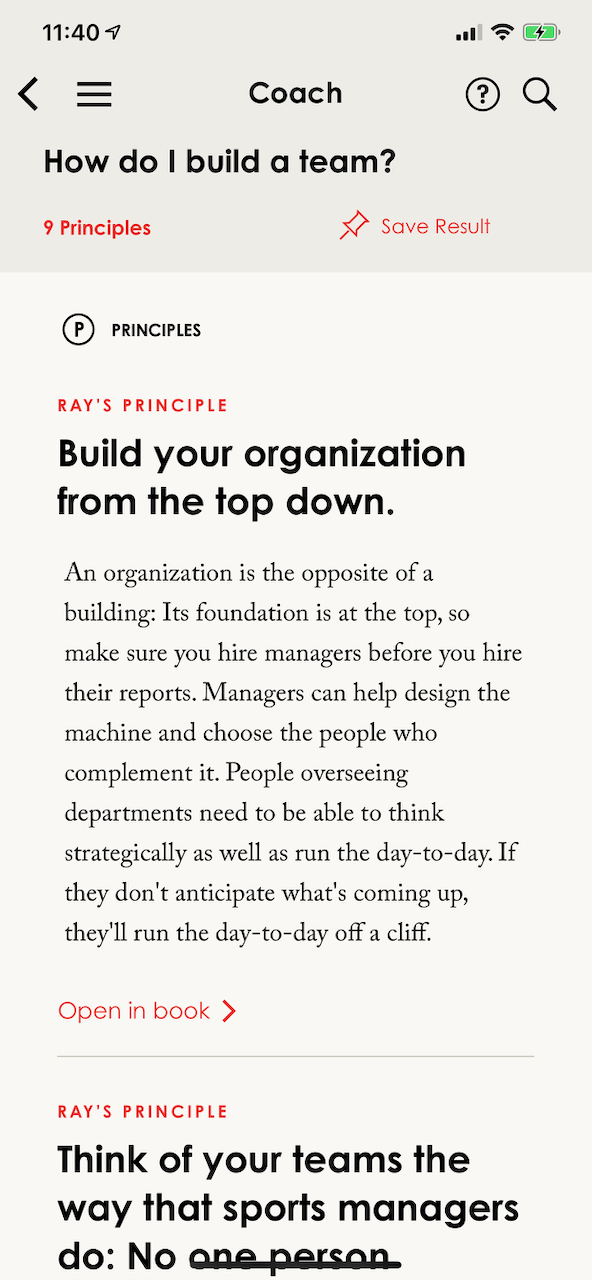To architect the Systems of Systems that will enable the emergence of a dream team, we’ll need some system design principles to guide our designs.
Let’s look to Burning Man as example.
10 Principles of Burning Man
- Radical Inclusion
- Gifting
- Decommodification
- Radical Self-reliance
- Radical Self-expression
- Communal Effort
- Civic Responsibility
- Leaving No Trace
- Participation
- Immediacy

These 10 principles taken together create the blueprints for a system that generates culture. This is the Dream of Burning Man.
If you have ever been, you’ll know what I’m talking about. If not, take a look at these Principles from Ray Dalio or Warren Buffet.
It’s worth downloading the the Principles in Action app from Ray Dailo for the Coach feature. You can type something like “team building” and get example principles you can riff off for your own dream team.
Without these principles defined at the outset, it’ll be random walk of trade-offs that yield a system potentially spawned from Hell — the dream of someone else.
These principles should be enduring for at least a decade of time. Here’s my set.
10 Principles of a Dream Team
- Embrace play
- Teach each other
- Focus first, multi-task second
- Sprint & rest cadence
- Progress calculus
- Surf between order & chaos
- Decentralize leadership
- Dymaxion
- Hybridization
- Continuous learning
Let’s briefly run through these principles to unpack them a bit. All of these principles will be further explored with specific examples as we deep dive into each dream team system.
Embrace play
The work environment should resemble a playground over an office that encourages one to take breaks to move and stretch their body.
Imagine meeting room floors that provide an ample amount of bounciness, integrated stall bars for mobility work, and yoga swings that allow one to easily get inverted for reversing the flow of cerebrospinal fluid and spinal decompression.
Teach each other
Unlike school, collaboration is the key to success. Everyone is both a student and teacher.
Embrace a Beginner’s Mind.
Focus first, multi-task second
Bias to focused work. Contain multi-tasking to specific time intervals.
Consistent practice of meditation to counter-act negative effects of multi-tasking.
Check out Focus - The Hidden Driver of Excellence on Blinkist for further research.
Sprint & rest cadence
Get after it, then rest up.
Both work and rest are equally important and should be built-into day-to-day, week-to-week, month-to-month, year-to-year cadences.
Progress calculus
Be disciplined about making progress, but don’t feel rushed. It takes time and iterations (over sleep cycles) to get closer to ‘perfect’.
The concept of ‘perfect’ is similar too ‘infinity’. Like in calculus, we are doing iterations to approach the limit of perfect.
Surf between order & chaos
Recognize the power of these opposing forces. Optimize for a balance between them — the bézier curve between yin and yang.
Decentralize leadership
Top down strategy. Bottom up tactics.
Keep the org as flat as possible with tactical decisions made by the people closet to the relevant domains of expertise.
Dymaxion
Dymaxion is a portmanteau of dynamic, maximum, tension. It’s a term coined by Buckminster Fuller.
Summed up as “maximum gain of advantage from minimal energy input”.
Hybridization
A purist approach will have distinct trade-offs. If a negative trade-off needs to become overcome; adopt a hybrid approach which seeks to attain “the best of both worlds” from multiple approaches combined in a novel way.
For example, I recently bought Hexclad cookware. It takes advantage of both non-stick and stainless steal approaches using a unique design of hexagonal printing. Thus their cookware provides the benefits of both non-stick (easy clean up) and stainless (durability).
The same goes for programming languages and our dream team systems. A pure functional language like Haskell has purist beauty, but I’d prefer a language that gives me flexibility of both functional and OOO styles.
Continual Learning
Learning is built-in into the cadence as knowledge work requires continuous learning.
We adopt best practices for knowledge acquisition, retention and sharing. Some of these best practices include: sleep, exercise, hands-on practice, and teaching.
All of our dream team systems need to have self-feedback mechanisms. Just like a recurrent neural network (RNN).
Principles define Culture
These are the principles that I’ll be using to guide the designs for these dream team systems:
- System for Hiring
- System for Structuring
- System for Executing
- System for Leveling Up
Remember your dream and dream team is different than mine. Define your unique cultural blueprints using System Design Principles.
It’s best to do this very early in your team’s lifecycle. These principles get exponentially harder to bolt on later as the team scales.
Culture takes time to ‘set’ and becomes hard to disrupt later (ossification). This is actually an amazing feature of culture; provided that you’ve set the right initial conditions, it’ll become progressively harder for it to become corrupted.
Culture is the secret sauce to making these systems actually work. Without a culture (defined by principles) these systems are just silly diagrams and theory — a culture makes them real.
If you’re feeling inspired, feel free to share your dream team principles with me. @hudaman on Twitter.
You can take this even further and define principles for Living your Life and Key Relationships. Before my wife and I got married, we first laid out our marriage principles in a google doc and agreed to those. Whenever a conflict arises, we can go back to our marriage principles for guidance.
NEXT> With our design principles in mind, let’s dive into a System for Hiring.
GOTO: Table of Contents
© 2019 Adam Huda - Written in California & Montana with iA Writer

